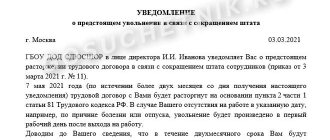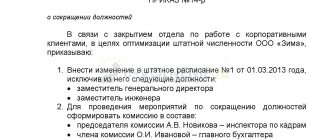What is dismissal due to reduction
A reduction in the number or staff of an organization’s employees is one of the grounds on which an employer can terminate a contract on its own initiative (Clause 2 of Article 81 of the Labor Code of the Russian Federation).
It is worth distinguishing that in the first case, the company reduces the number of employees in one position (for example, instead of 8 lawyers there are 4 left), and in the second, certain categories of positions are completely excluded from the staffing table. Contrary to popular belief, the employer can make such a decision at any time without any justification or explanation to employees, the trade union or third parties, which is confirmed in the Resolution of the Plenum of the Armed Forces of the Russian Federation dated March 17, 2004 No. 2. Which is quite logical, since the issue of staff reduction concerns organization of activities within the enterprise and depends on the success of business. It is also not mandatory for company management to obtain the consent of a citizen or trade union. However, notifying the employee and obtaining the opinion of the trade union are one of the conditions for maintaining the legality of the dismissal procedure for staff reduction. In addition, payment of all compensation required by law is required.
Early layoff
The employee must be notified at least 2 months in advance of an upcoming dismissal due to a reduction in numbers or staff. If the employee and employer agree, dismissal can be formalized before the end of this period. In this case, the employee is entitled to additional compensation (Article 180 of the Labor Code of the Russian Federation).
IMPORTANT. Receiving compensation for early dismissal does not deprive the employee of the right to severance pay, as well as to payment of average earnings for the period of employment.
Additional compensation is calculated as follows. First, you need to determine the average daily (if working time is calculated hourly) earnings of the laid-off employee based on data for the previous 12 months. The resulting value should be multiplied by the number of working days (with cumulative accounting - hours) that fall after the day of “early” dismissal and before the day of “planned” layoff (Part 3 of Article 180 of the Labor Code of the Russian Federation).
Additional compensation, like other amounts due upon dismissal, is paid on the last day of work upon final payment (part 4 of article 84.1 of the Labor Code of the Russian Federation, part 1 of article 140 of the Labor Code of the Russian Federation). This compensation in full is not subject to personal income tax or insurance contributions (letters from the Ministry of Finance dated 03.08.17 No. 03-04-06/49795 and dated 31.07.17 No. 03-04-07/48592, Federal Tax Service dated 21.08.17 No. BS- 4-11/ [email protected] ).
It happens that after receiving a notice of dismissal due to reduction, an employee decides to terminate the employment contract on his own initiative. In this case, it is enough for him to submit a letter of resignation of his own free will. However, he will not receive any additional payments, including severance pay and average earnings for the months after dismissal. Therefore, in order to avoid conflict situations, we recommend that you notify the resigning employee of such consequences against signature.
Dismissal procedure: list of actions
Since the legislator seeks to protect the interests of workers as much as possible, the reduction procedure is quite strictly regulated. A certain algorithm must be followed:
- Issuance by the manager of an order to reduce staff and approval of a new staffing table or changes to be made to it.
- Notification of the employment service and trade union.
- Determining the circle of persons who have the right of priority to remain at work.
- Delivery of layoff notices to staff against signature.
- Offering laid-off employees free vacancies, that is, other jobs.
- Requesting the union's opinion on the dismissal of an employee who is a member of it.
- Termination of the employment contract.
- On the day of dismissal due to staff reduction, a settlement is made with the employee, and a work book is issued with a note of dismissal due to staff reduction on the basis of clause 2 of Art. 81 Labor Code of the Russian Federation.
Rules for payment of severance pay upon dismissal by agreement of the parties
Art. 78 of the Labor Code establishes the rule: an employment contract can be terminated at any time by agreement of the parties.
Often, in an effort to avoid the complex procedure of staff reduction, the employer chooses dismissal by agreement of the parties, but with the payment of severance pay. And although the Labor Code does not stipulate anywhere that the employer is obliged to pay severance pay to employees dismissed by agreement of the parties, he can do this by virtue of Art. 178 TK.
Many employers try to make do with one statement from the employee, on which they base the resolution. But it is better, when dismissing by agreement of the parties, to draw up an agreement to terminate the employment contract by agreement of the parties, fixing a number of important issues:
- what date will be the last day of work, that is, the day of dismissal;
- the fact that the employee will be fired precisely under clause 1 of Art. 77 Labor Code, that is, by agreement of the parties;
- what amounts will be paid to him;
- that the parties have no mutual claims, etc.
Typically, such an agreement is drawn up in two copies.
When drawing up an agreement, you should pay attention to the employee’s employment contract. If it does not indicate that if an employee is dismissed by agreement of the parties, he will be paid a certain amount of severance pay, then this condition must be included in the employment contract.
This is done simply: an additional agreement is drawn up to the employment contract, which stipulates the condition for the payment of severance pay in a certain amount.
The Ruling of the Supreme Court of the Russian Federation dated August 10, 2015 No. 36-KG15-5 provides an interesting situation: the employee and the employer agreed that upon dismissal, by agreement of the parties, the employee would be paid severance pay, they drew up an agreement on the termination of the employment contract, where they prescribed the payment of severance pay benefits. After this, the employer dismisses the employee by agreement of the parties, leaving him without severance pay.
The employee goes to court. And the Supreme Court confirms the legality of dismissing an employee by agreement of the parties without paying severance pay. The court considered that since Art. 178 of the Labor Code says that other cases of payment of severance pay must be provided for by an employment or collective agreement, which was not the case in this case (there was only an agreement to terminate the employment contract), then all the actions of the employer are legal.
Step-by-step instruction
Step 1. Before issuing an order to reduce staff or number of employees, it is necessary to make such a decision in accordance with the procedure established in the organization. It is necessary to identify positions that are subject to reduction, make sure that the list of those being dismissed does not include citizens who cannot be dismissed on this basis, and identify persons who are granted benefits by law. It is necessary to take into account that employees with higher qualifications have a preferential right to retain their jobs. When deciding who exactly will be laid off, the presence of dependents, injury at work or occupational illness, and the presence of other breadwinners in the family are taken into account. The order must indicate which staffing units and in what quantity are subject to exclusion from the staffing table, the reason for making such a decision, describe in detail the upcoming reduction procedure, indicating all activities and the timing of their implementation, as well as provide a list of responsible persons at all stages. All responsible persons are familiarized with the order and signed.
Step 2. All notifications to interested parties are sent on time in the approved or recommended form. It is imperative that all notices be dated so that there is evidence that deadlines have been met. It is possible to dismiss employees before two months only with their written consent with the payment of additional compensation for average earnings according to the remaining time of work, according to the notice.
Step 3. Before issuing a notice, you need to offer another job. Moreover, the legislation does not indicate that the proposed workplace must correspond to the previous one or the qualifications of the specialist. If you are being made redundant, you can also offer a low-paying job, lower in position, this is allowed. Of course, all notifications and refusals of offered work, which the employee also does not have to explain, are documented in writing. It is a mistake to think that in any case you can limit yourself to one sentence. If new vacancies suitable for health reasons appear within a two-month period, the employer is obliged to offer them to the dismissed employee.
Step 4. The notification to the employment service must indicate the positions, professions and specialties of the dismissed workers. In addition, you need to notify the employment service about their level of qualifications and the conditions of payment for each employee. The employment service must be notified of mass layoffs three months in advance. The employment service is obliged to inform the prosecutor's office about all enterprises that have not sent a notice of staff reduction.
Step 5. Based on the general order, a specific order is issued for each employee with whom he gets acquainted with signature. The contract is terminated after the expiration of a two-month period (the period is counted from the next day after receipt of the notification) and after changes are made to the staffing table. Moreover, there should be no similar vacant positions left in the staffing table, otherwise the legality of the employer’s decision may be challenged. The order is issued in a unified form, the work book is drawn up in accordance with the Labor Code of the Russian Federation.
Step 6. Payment of compensation.
What to consider when dismissing an employee
A manager, making a difficult decision about who will stay and who will be laid off, cannot be guided by his own desires or aversions. Retrenchment comes with a right of first refusal, meaning that some employees are less likely to be laid off than others. Let's consider the factors that influence the choice of a manager (Article 179 of the Labor Code of the Russian Federation).
- Employee qualifications . Persons with higher qualifications have priority.
- Labor productivity . Those who perform better or exceed established standards, have fewer or have not been subject to administrative penalties, awards or other incentives, should be less afraid of layoffs than employees with less rosy reputations.
- Other priorities. If points 1 and 2 are approximately equal for different employees, the manager will choose to remain at work:
- having 2 or more offspring or other dependents;
- the sole breadwinner of the family;
- combat disabled person;
- an employee who was previously injured at the enterprise;
- employee sent to improve their skills.
- Preferential categories . All other things being equal, the preferential right will be on the side of employees who were “Chernobyl survivors” (clause 7, clause 1, article 14 of the Law “On Social Protection” of May 15, 1991), persons affected by the tests in Semipalatinsk (clause 10, art. 2 Federal Law No. 2 of January 10, 2002), as well as Heroes of the USSR and Russia and full Order Bearers of Glory (clause 1 of Article 8 of Law No. 4301-1 of January 15, 1993)
A comparative analysis of all these points should be reflected in the personal files of each candidate for dismissal.
Who should not be fired
To avoid negative consequences and fines, the employer must remember which employees, due to their special situation, cannot be laid off, in accordance with Article 261 of the Labor Code of the Russian Federation:
- pregnant women;
- workers with children under three years of age;
- single mothers with a disabled child who has not reached the age of majority;
- single mother with a child under 14 years old;
- other persons who raise such children without a mother.
Also, an employer cannot unilaterally dismiss an employee who is on sick leave or on vacation (Article 81 of the Labor Code of the Russian Federation).
Features of dismissal of pensioners, pre-retirees, part-time workers and other categories of workers
Pensioners are dismissed due to staff reduction in the same manner, with the same compensation being paid. The only controversial issue remains the payment of the third benefit, since a pensioner cannot register with the employment service and receive benefits, since he receives a pension. However, if there are circumstances worthy of attention, employment centers provide pensioners with the certificates necessary to receive the third benefit.
Rostrud recommended that employers separately consider the issue of providing pre-retirees with a preferential right to retain their jobs in case of staff reduction. This is logical, because if there is a suspicion of dismissal due to reaching the appropriate age, the administration may be held criminally liable.
The part-time worker is paid the average monthly salary for the second and third months only if he provides evidence in the form of an entry in the work book about dismissal from the main place of work before dismissal from the part-time job.
A seasonal employee is notified 7 days in advance of a planned dismissal, and is paid compensation in the amount of two weeks' average earnings. No other compensation is provided for them.
Northerners, or residents of the Far North, can qualify for average earnings for 4-6 months of unsuccessful employment if they provide the appropriate documents from the employment service, provided that they are registered within 30 days from the date of dismissal. The third allowance is issued even in the absence of registration.
The nuances of dismissal during reduction
Staff reduction is the elimination of one or more vacancies and their removal from the staff list. Employees can be fired both in the company and at the individual employer. For example, a retail outlet moves from offline to online trading. Then the positions of salespeople, consultants, and cashiers are eliminated, and employees are either offered another job or laid off due to layoffs.
Another reason for dismissal is a reduction in the number of personnel. In this case, the number of positions in the state remains the same, but the number of staff units is reduced. The only difference between the two types of abbreviations is this. There are no other fundamental differences. It also happens that both types of contractions are carried out simultaneously.
Calculation example
Ivanov I.I. worked as a manager for two years and was dismissed due to staff reduction on 01/01/2018. On January 10, he contacted the employment center and was registered, but could not find a job until 04/01/2018, that is, until that moment he retained his unemployed status. Ivanov I.I.’s work schedule was standard with a 5-day work week. Initial data: for 2021 Ivanov I.I. he worked 247 days, 28 calendar days and 19 working days he was on vacation: from 08/01/2017 to 08/28/2017. The salary of Ivanova I.I. was unchanged for the entire 2021 and amounted to 30,000 per month.
Formula for calculating severance pay by Ivanova I. upon dismissal due to staff reduction:
- actual shifts worked: 247 - 19 = 228;
- average salary per day: 331,428.57 / 228 =1453.63;
- amount for January: 1453.63 × 17 = 24,711.71;
- February amount: 26,165.34;
- amount for March: 31,979.86.
Ivanov would be entitled to benefits for the first month, that is, payment of compensation for January, even if he was employed. But benefits for February and March, if you start a new job during these months, would be calculated in proportion to the days of unemployment.
How to calculate the due amount
Upon dismissal due to staff reduction, severance pay is paid. To calculate its value, determine the average daily income. It is calculated taking into account the previous 12 months before dismissal. When an employee’s dismissal occurs on the last day of the month, the entire month also falls into the billing period.
VP = RNd* SDZ, where
- VP is severance pay.
- RNd - working and non-working holidays for the first month after the layoff.
- SDZ - average daily earnings.
For those who work on seasonal pay, working and non-working holidays for the next 2 weeks from for reduction are taken into account.
In cases where an employee is given a summary record of working time, the number of working hours is taken into account. That is, you need to draw up a schedule for the next month as if the employee continued to work.
Additional guarantees
In addition, current legislation establishes another guarantee for employees - preservation of wages during the period of employment. According to Article 178 of the Labor Code of the Russian Federation, a dismissed employee retains his average monthly earnings for a period not exceeding two months. In exceptional cases, a salary can be issued for the third month of unsuccessful job search (if the citizen registered with the employment service within two weeks from the date of dismissal), but the employee must provide confirmation from the employment service that he applied to this body and was not employed.
Longer terms for maintaining the average wage are established for those who work in the Far North and equivalent territories. For such categories of workers, the paid period of employment can be up to six months after layoff (Article 318 of the Labor Code of the Russian Federation).
What does the employer pay when laying off workers?
Each employee who is fired for any reason is entitled to the following basic payments:
- earnings for actual time worked;
- premium;
- vacation compensation.
In addition to these, those employees who are laid off are entitled to other mandatory payments:
| Payments | Characteristic |
| Vacation pay compensation | Payments for unspent vacation can only be received by those employees who did not take a single day of vacation in a given year and worked for 5.5 months. If an employee has used several days of vacation, then only the unspent portion is compensated. |
| Severance benefits | This type of payment is due to all employees, except those with whom an employment contract has been concluded for a period of up to 2 months. They are given money only if this is specifically agreed upon in the contract. The amount of the benefit is equal to the amount of average monthly earnings. |
| Compensation after dismissal | If an employee does not get another job in the first month, then his average monthly income is retained for this month. This rule is only suitable for regular workers, and not for seasonal workers. For the second month, payments are calculated according to the data from the work book. If there is no information about a new job, then the money is given in full. If there is a record, but not at the beginning of the month, then the former employer pays the average salary for the days while the former employee remained unemployed. The third month without work is confirmed by a special document from the employment service. But the employer can already file a complaint. If the document is found illegal in court, the employer will be compensated for the money issued from the budget. |
Contributions and personal income tax are not withheld from the amounts paid if the amount of payments to the employee upon layoff does not exceed three average monthly salaries. But if the amount is larger, taxes on the income will be paid. Such deductions are carried out by the accounting department at the place of former work. Money is issued in cash or to a bank card.
Retirement
Russian legislation also has such a concept as early retirement. According to Art. 32 Federal Law “On Employment...” dated April 19, 1991, persons have the right to apply for early retirement if the following conditions are met:
- at least 20 years of experience for women and 25 for men;
- age is 2 years less than the established retirement age;
- lack of employment opportunities for another job. This circumstance must be confirmed at the employment center.
When such persons are laid off, they have the right to retire early, but only with their consent. After employment or retirement, payments stop.
To whom compensation is not paid?
In Article 349.3 of the Labor Code of the Russian Federation, the legislator established a restriction on the provision of severance pay for managers, their deputies, chief accountants, as well as members of executive bodies:
- state corporations;
- organizations in whose authorized capital the share of participation of the Russian Federation is more than 50% of state extra-budgetary funds;
- state and municipal institutions.
However, if the payment of compensation is provided for in an employment or collective agreement, then it is still paid, but in a limited amount - no more than three average monthly salaries.
Responsibility for violation of payments
For violation by the employer of labor legislation and failure to pay statutory deductions on time, Part 6 of Article 5.27 of the Code of Administrative Offenses of the Russian Federation provides for the following fines:
- for officials - from 10,000 to 20,000 rubles;
- for persons carrying out entrepreneurial activities without forming a legal entity - from 1000 to 5000 rubles;
- for legal entities - from 30,000 to 50,000 rubles.
Order to reduce staff
Order to dismiss an employee
Terms of accrual and procedure for payment of benefits
As a general rule, payment of redundancy benefits must be made on last working day . If this is not possible, the amount must be transferred no later than the day following the day the employee applies for payment (Article 140 of the Labor Code of the Russian Federation).
In practice, in order to assign severance pay when reducing staff, an order is issued in any form, although the law does not require the publication of such a document. It usually includes:
- information about dismissed employees;
- grounds for termination of employment relations;
- payment amount;
- an order for the accountant to make the appropriate payment.
SAMPLE ORDER ON ASSIGNMENT OF BENEFITS IN TERMINATION






